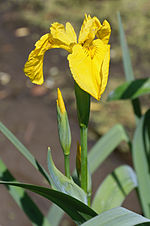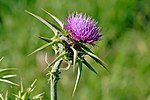Nectar guides are markings or patterns seen in flowers of some angiosperm species, that guide pollinators to their rewards. Rewards commonly take the...
4 KB (426 words) - 19:50, 27 March 2023
Hummingbird (section Perception of sweet nectar)
Noted for long beaks, hummingbirds are specialized for feeding on flower nectar, but all species also consume small insects. They are known as hummingbirds...
165 KB (17,671 words) - 03:33, 24 September 2024
Iris pseudacorus (section Nectar production)
foetidissima (stinking iris). The plant was rated in second place for per day nectar production per flower in a UK plants survey conducted by the AgriLand project...
12 KB (963 words) - 21:38, 22 August 2024
species is named for its similarity to hummingbirds, as they feed on the nectar of tube-shaped flowers using their long proboscis while hovering in the...
18 KB (1,888 words) - 12:59, 14 August 2024
A Bellini is a cocktail made with Prosecco and peach purée or nectar. It originated in Venice, Italy. The Bellini was invented sometime between 1934 and...
6 KB (567 words) - 15:30, 19 August 2024
gathering and then refining the sugary secretions of plants (primarily floral nectar) or the secretions of other insects, like the honeydew of aphids. This refinement...
124 KB (13,363 words) - 01:11, 30 September 2024
Caribbean. It is the smallest known bird. The bee hummingbird feeds on nectar of flowers and bugs found in Cuba. The bee hummingbird is the smallest living...
16 KB (1,434 words) - 02:27, 12 September 2024
feed on nectar, using their long hairy tongues to lap up the liquid; the proboscis is folded under the head during flight. Bumblebees gather nectar to add...
107 KB (11,622 words) - 02:46, 29 September 2024
Taraxacum (redirect from Dent-de-Lion)
a generalist species, dandelions are one of the most vital early spring nectar sources for a wide host of pollinators. Many Taraxacum species produce seeds...
49 KB (4,645 words) - 04:02, 21 September 2024
Bat (section Fruit and nectar)
insectivores, and most of the rest are frugivores (fruit-eaters) or nectarivores (nectar-eaters). A few species feed on animals other than insects; for example,...
171 KB (18,271 words) - 16:06, 4 October 2024
October 2022. "Hierbas - Nectar of the Gods". Affordable Mallorca. Retrieved 12 October 2022. "Hierbas". www.majorca-guides.info. Retrieved 12 October...
4 KB (361 words) - 06:27, 16 September 2024
system for avian nectar-robbery studies". Scientific Reports. 12 (1). doi:10.1038/s41598-022-16237-9. PMC 9279294. Art. No. 11936. "Field Guide: Sphinx Moths...
11 KB (1,076 words) - 16:08, 11 August 2024
Conservation Practitioner's Guide". The Xerces Society. Retrieved 27 August 2018. "Which flowers are the best source of nectar?". Conservation Grade. 15...
27 KB (2,882 words) - 03:14, 6 August 2024
Hoverfly (section Identification guides)
suggests, they are often seen hovering or nectaring at flowers; the adults of many species feed mainly on nectar and pollen, while the larvae (maggots) eat...
25 KB (2,712 words) - 03:50, 7 October 2024
are much smaller than drones or queen bees, with bodies specialized for nectar and pollen collection. They perform different tasks around the hive progressively...
21 KB (2,597 words) - 14:04, 6 July 2024
Pteropodidae. Despite its scientific name, it feeds exclusively on fruits, nectar, and flowers, like the other flying foxes of the genus Pteropus. It is noted...
21 KB (2,225 words) - 01:05, 14 June 2024
adapted to gathering pollen and nectar from flowers. Nectar from eucalyptus is important in Australia, other important nectar sources are Pittosporum, Grevillea...
22 KB (2,257 words) - 20:41, 18 August 2024
Mosquito (category CS1 German-language sources (de))
specialized, highly elongated, piercing-sucking mouthparts. All mosquitoes drink nectar from flowers; females of some species have in addition adapted to drink...
93 KB (9,200 words) - 01:45, 27 September 2024
Horned sungem (category CS1 German-language sources (de))
flowering plants for nectar. If the shape of the flower is incompatible with the bird's comparatively short bill, it may rob the nectar through a little hole...
33 KB (3,334 words) - 07:33, 20 August 2024
flowers. Some flowers have patterns, called nectar guides, that show pollinators where to look for nectar; they may be visible only under ultraviolet...
103 KB (11,623 words) - 21:38, 26 September 2024
rather a result of the paucity of nectar sources in late summer in urban areas. The evidence against a toxin in the nectar being responsible for mass bee...
7 KB (747 words) - 03:31, 16 April 2024
milkweed and violets, respectively. As adults, butterflies feed mainly on nectar, but they have also evolved to consume rotting fruit, tree sap, and even...
77 KB (7,365 words) - 18:36, 2 October 2024
most famous for its predation of black widow spiders. Adults feed on the nectar of flowers, which powers their flight. They pollinate some common wildflowers...
4 KB (381 words) - 23:53, 20 March 2024
Some small pollinating mammals consume large amounts of fermented palm nectar as part of their diet, especially the Southeast Asian pen-tailed treeshrew...
31 KB (2,884 words) - 14:57, 15 September 2024
leaves have a mild lemon scent. During summer, small white flowers full of nectar appear. It is not to be confused with bee balm (genus Monarda), although...
17 KB (1,695 words) - 10:49, 20 August 2024
Euphorbia (category CS1 German-language sources (de))
have sepals, petals, or nectar to attract pollinators, although other nonflower parts of the plant have an appearance and nectar glands with similar roles...
37 KB (3,462 words) - 05:20, 5 August 2024
Nicolson, Susan; Leo de Veer; Angela Kohler; Christian W. W. Pirk (2013). "Honeybees prefer warmer nectar and less viscous nectar, regardless of sugar...
26 KB (3,196 words) - 02:15, 29 September 2024
beetles commonly called flower chafers since many of them feed on pollen, nectar, or petals. Its habitat is primarily the southwestern United States (including...
8 KB (943 words) - 08:21, 10 August 2024
environments but also has been found in dry soil or sand. The seeds and nectar of this mostly conservationally secure species, which blooms August to November...
57 KB (4,466 words) - 17:41, 6 October 2024
You'll Read All Day". The Daily Meal. Retrieved 20 August 2016. Chopped episode guide at FoodNetwork.com Chopped Junior episode guide at FoodNetwork.com...
243 KB (81 words) - 16:57, 25 August 2024





























